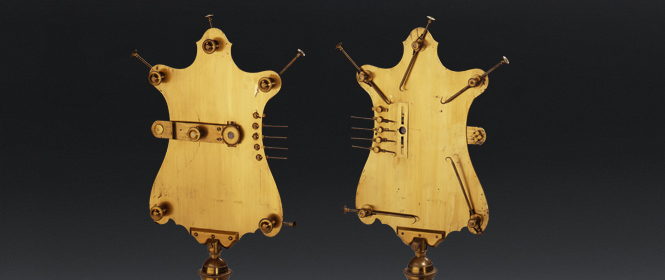
THE CIRCULATORY SYSTEM OF FROGS
In our ‘What’s that for?’ series, we take you on a journey through the scientific history of the 18th century and introduce you to unexpected, strange and surprising objects from our permanent exhibition.
It shines in gold and looks like an objet d’art, but it has nothing to do with decoration or jewellery. Known as a ‘frog plate’ or ‘anatomic microscope’, it transports us straight back to the science-mad 18th century. It was originally made by Johann Nathanael Lieberkühn (1711–1756) in 1743 and described in Men. De l’acad. de Berlin, 1743 of the Berlin Academy of Sciences, of which Lieberkühn became a full member in the same year.
STUDIES OF LIVE ANIMALS
The frog plate, which features an eyepiece and a stage, was used to train veterinarians. The user would study live animals. On the stage, live frogs, fish and other small creatures would be skewered on rotating and swivel-mounted nails. The lens was then used to observe the animal’s circulatory system and the movements of its internal organs. Lieberkühn left behind detailed drawings and instructions for posterity. These were used to build such plates into the 19th century. Apart from in our permanent exhibition, an anatomic microscope can also be found in Berlin’s Charité hospital, where Lieberkühn once taught anatomy.
NATURAL SCIENCES AS A PUBLIC SPECTACLE
Lieberkühn developed a veritable repertoire of mechanical and physical instruments. They were showcased to the science-mad populace of the 18th century by gifted entertainers at huge public spectacles. Lieberkühn’s famous ‘sun microscope’ even made it to Britain, where Thuringian con man Gustav Katterfelto (1743–1799) presented it and even sold it as his own invention. The audience were transfixed by the teeming diversity of ‘insects and polyps’ that were revealed by the microscope.
The frog plate is situated on the upper floor of our permanent exhibition, right next to the important studies of Swedish botanist Carl von Linné (1707–1778) and the work entitled De Europische Insecten by naturalist Maria Sybilla Merian (1647–1717). The contents of the display case let you find out more about the spirit of experimentation and thirst for knowledge of the late 18th century, as well as the associated fascination with electricity, magnetism and physiology.